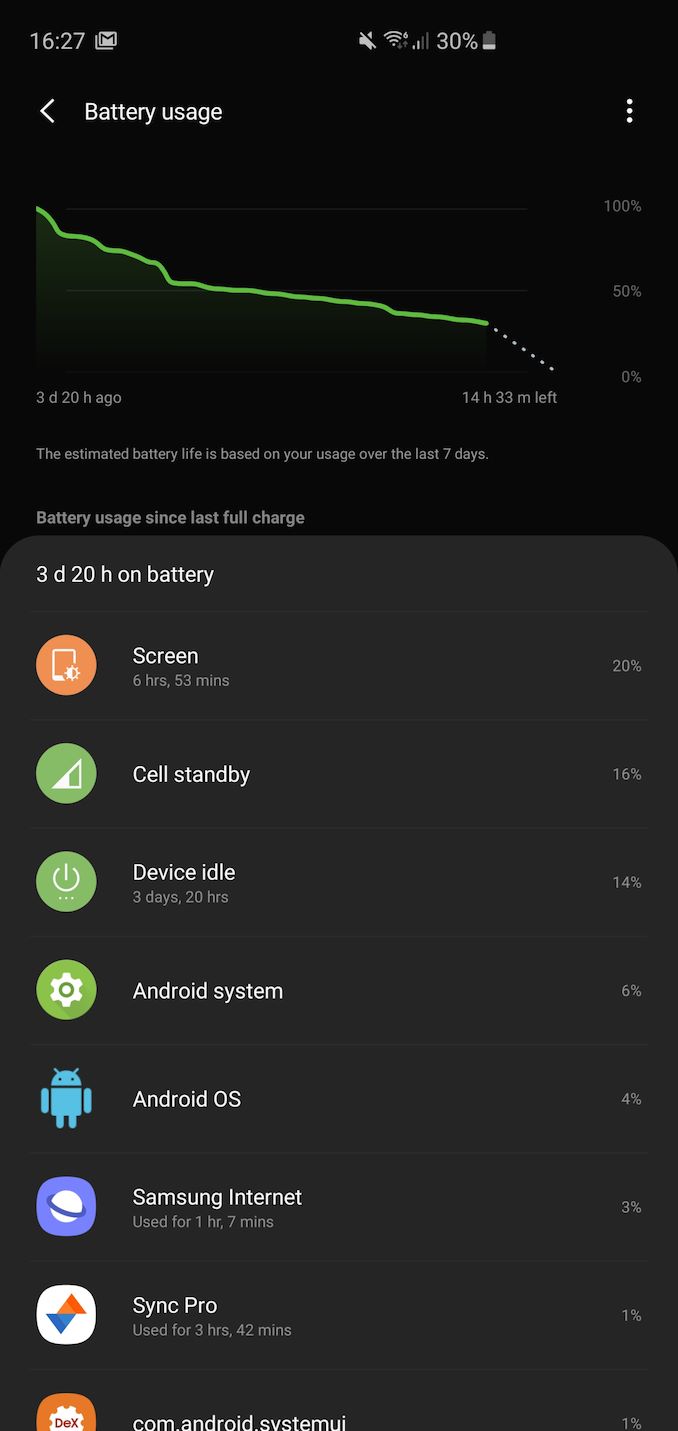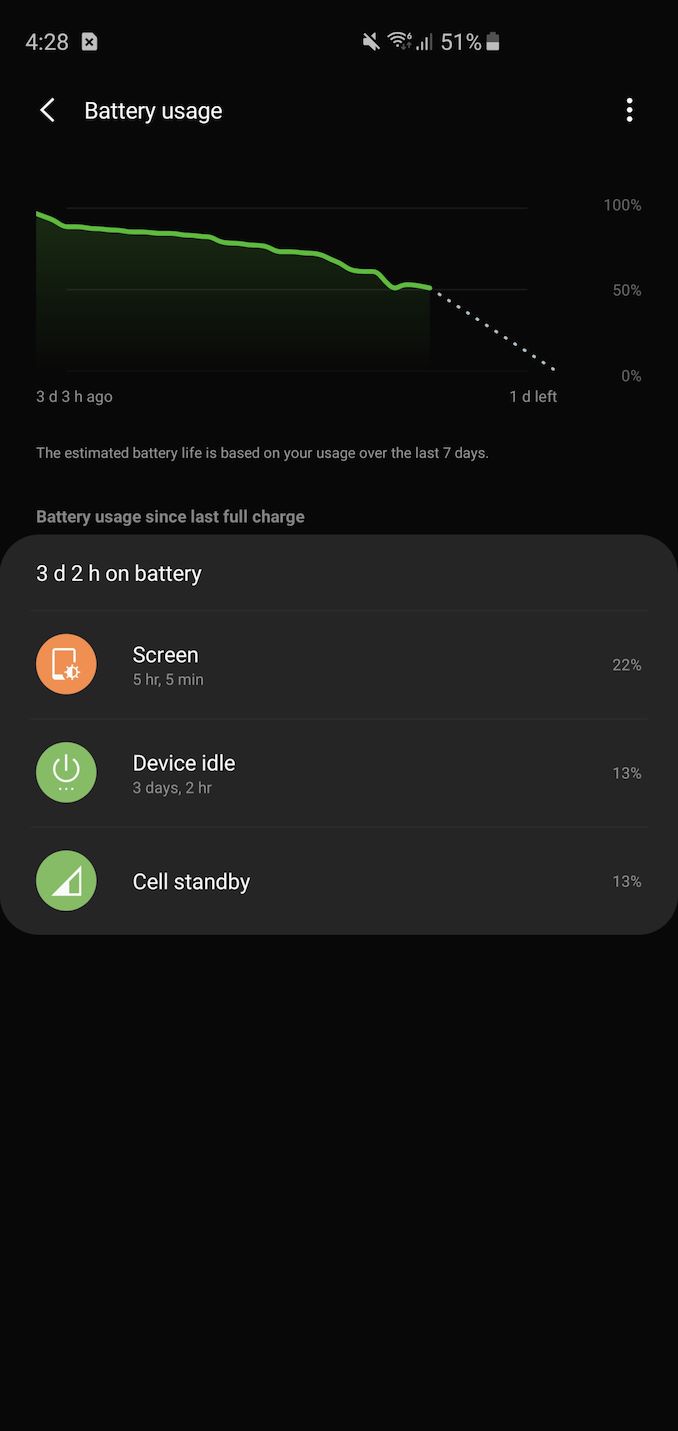The Samsung Galaxy S10+ Snapdragon & Exynos Review: Almost Perfect, Yet So Flawed
by Andrei Frumusanu on March 29, 2019 9:00 AM ESTBattery Life: Impressive
Battery performance of the Galaxy S10+ has been touted to be as class-leading. The introduction of a larger battery, more efficient screen as well as a new generation of SoCs are sure to bring improvements over last year’s Galaxy S9. One aspect that readers will have waited for impatiently is our testing of the new Exynos 9820 variant against the Snapdragon 855, which has also been one topic I’ve been extremely interested to see.
We run Samsung's Galaxy devices at the full potential they can deliver, something we've done for several generations now. This means that the screen resolution is set to the native 1440p of the display panels, and the new battery settings on the S10 were also set to "Performance" mode.
Without further ado, let’s get do the results:

In our web browsing test, both Galaxy S10+s are showcasing outstanding longevity at 13.08h for the Exynos and 12.75h for the Snapdragon variant. Least to say, I was extremely surprised to see this result even though we measured the Exynos 9820 CPU to be quite less efficient than the Snapdragon 855 in peak performance efficiency. I would have not expected the Exynos to match the Snapdragon, much less slightly beat it.
Before going into more details, let’s see the PCMark battery test results:

Here, in absolute terms, the Galaxy S10+ aren’t quite as impressive as on the web test and further lag behind the excellent results of the Kirin 980 devices. Nevertheless, these are some impressive figures and again it’s very good to see that both units are almost evenly matched, this time the Snapdragon unit lasting slightly longer than the Exynos.
To explain these results, we have to keep one thing in mind: the Exynos unit will have posted worse performance than the Snapdragon, so it will have spent more time at the lower more efficient frequency states.
One thing that I also noticed, is that in very low idle loads where there’s just some light activity on the A55 cores, the Exynos 9820 variant actually uses less power than the Snapdragon unit. The figures we’re talking about here are 20-30mW, but could possibly grow to bigger values at slightly more moderate loads. It’s possible that Qualcomm has more static leakage to deal with on the 7nm process than Samsung on 8nm, one thing that I’ve come to hear about the TSMC 7nm node.
Furthermore, one of the biggest improvements for the Galaxy S10 over past devices isn’t actually the SoC nor the actual bigger battery. It’s actually the display as well as the base power consumption of the phone. In Airplane mode, the base power has gone down by almost 100mW compared to the Galaxy S9+ which is a fantastic development and is especially something that will result in higher low-brightness battery life.
Currently in my time with both S10+ units, I can say they’ve been among the longest lasting Android devices I’ve tested.


Exynos vs Snapdragon in identical usage patterns & Prolonged idle periods
One issue I can confirm with the Exynos unit is that after a voice call in any app, the phone isn’t correctly entering its lower power state, and will suffer from increased idle battery drain until a reboot. This is something that hopefully Samsung addresses in a firmware update as it doesn’t look to be a hardware related issue. When not affected by this bug, both phones idle very similar to each other and slightly better than the S9+ I use as my daily device.










229 Comments
View All Comments
Tropicocity - Sunday, March 31, 2019 - link
Very true. I went from the S4 to the S7 edge, now my S10+ is on the way. Meaningful upgrades!catavalon21 - Thursday, August 22, 2019 - link
You've certainly never been an average Apple fan, then.../* sarcasm off
Monty1401 - Friday, March 29, 2019 - link
I would argue the battery life alone is worth the upgrade (exynos s9+ here)jordanclock - Friday, March 29, 2019 - link
All of the deep dive information is great, but the graphs having different scales makes them very difficult to compare. Can you normalize the Y-axis on the graphs so that switching between them can be immediately compared?jaju123 - Friday, March 29, 2019 - link
Andrei, got any opinions for us peasants of inferior knowledge and skill living in the EU whether to go for the S10+ or P30 pro based on your experience thus far? Seems like the P30 pro may be having performance issues to me, or so I've seen on some youtube videos, particularly with throttling. Many thanks.Andrei Frumusanu - Friday, March 29, 2019 - link
Don't worry I'm also an EU peasant.I only got the P30's a few days ago at release and haven't really used it much as I was busy finishing this up. Performance at first glance looks the same as other Kirin 980 devices which found to be good although missing some OS booster in Snapdragon chips or the new S10.
That review should follow up in the next week or two.
jaju123 - Friday, March 29, 2019 - link
Great thanks, looking forward to the review.I currently have a mate 20 pro, but have itchy trigger fingers and usually buy 2nd hand to save some cash and upgrade quite a bit a few months after these things release. Finding that the main issue with the camera on this device is the white balance being incorrect quite often, but the addition of OIS on the main lens of the P30 pro looks like it could make quite a difference. I am also wondering if the 40mp sensor is in reality all that different from the mate 30 pro/p20 pro?
Ironically, I think that if Oneplus released a true flagship Oneplus 7+ with waterproofing, 4200mah battery and epic camera quality at the 1000$ pricepoint I think that would blow away the rest of the competition.
Andrei Frumusanu - Friday, March 29, 2019 - link
> I am also wondering if the 40mp sensor is in reality all that different from the mate 30 pro/p20 pro?It should be fundamentally different due to the RYYB structure.
eastcoast_pete - Friday, March 29, 2019 - link
Andrei, thanks for this review. Question: How is the call quality, especially if used as speakerphone? The loudspeaker analysis looks promising, but calls also depend on microphones, noise suppression etc. Thanks!Andrei Frumusanu - Friday, March 29, 2019 - link
Call quality on this side is great, the speakers are fantastic, although I admit I didn't really test microphone quality on the other side.